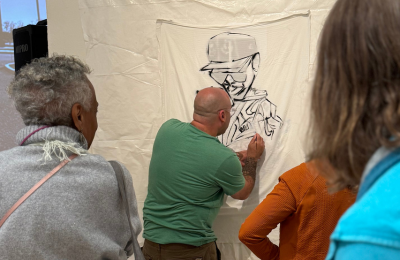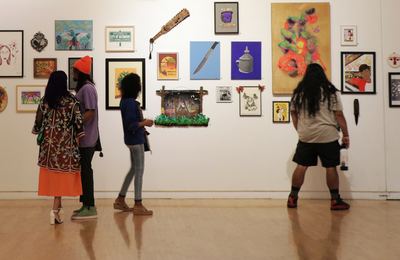Arts Education Transforms Societies

We are seeing so many articles and studies these days which point to the many benefits of arts education. This latest article, Arts Education Transforms Societies, from the Huffington Post creates a link to what we’ve been saying for a while: Creativity and independent thinking are the skills that will create tomorrow’s entrepreneurs.
Plus these amazing statistics and facts about Arts Education:
- 1,500 CEOs from around the world named creativity as the leading skill needed for business success.
- Arts education increases employment rates by raising high-school graduation rates.
- Low-income students who are highly engaged in the arts are more than twice as likely to graduate from college as their peers with no arts education.
- Low-income students with a high participation in the arts have a dropout rate of 4 percent, in contrast to their peers with a low participation in the arts who have a dropout rate of 22 percent.
This year, our Art in the Community program will bring free programs to teach more than 1,600 local children through dozens of after-school and summer programs at elementary, middle and high schools, community centers, the Richmond Main Public Library and our most recent addition, a day-time program at Washington Elementary School in Richmond. These programs are entirely supported through the generosity of foundations, businesses and individuals.
Arts Education Transforms Societies
By Robert L. Lynch
Do you enjoy the sleek look of your new iPhone? You can thank Steve Jobs for taking a calligraphy class at Reed College. Have you or your kids scribbled on a pair of Vans sneakers? Vans’ President Kevin Bailey credits the brand’s creativity with the arts education many of his employees have taken. At her promotion and swearing-in ceremony a few weeks ago, Capt. Moira McGuire, assistant chief of Integrated Health and Wellness at Walter Reed National Military Medical Center, credited the arts as central to her practice as a caregiver for our wounded, returning military veterans. These are just a few of today’s leaders crediting their success to arts education.
Although many people may agree that arts (music, theatre, dance, visual, media, literary and more) are an important part of education, they may not realize the powerful trickle-up effect of arts education on a modern, innovative workforce. Indeed, arts education has the power to transform societies for the better.
Arts education increases employment rates by raising high-school graduation rates. Last year, high school graduates had a 3.5 percent lower unemployment rate than those without diplomas. And when exposed to arts education, students of all backgrounds are more likely to graduate. Americans for the Arts’ research shows that low-income students who are highly engaged in the arts are more than twice as likely to graduate from college as their peers with no arts education. Additionally, low-income students with a high participation in the arts have a dropout rate of 4 percent, in contrast to their peers with a low participation in the arts who have a dropout rate of 22 percent.
Once they graduate, students who have had arts education are more likely to hold onto jobs and thus positively contribute to the economy. According to a 2012 study in the Cambridge Journal of Regions, Economy and Society, jobs in the creative areas–such as engineers, artists, scientists and educators–experienced lower rates of unemployment during the 2008-2010 recession than those in service or production jobs, even when employees had the same level of education. Furthermore, the researchers note that those in creative jobs are more resilient to technology advancements and outsourcing than other careers.
Students with exposure to arts education are also more prepared for the jobs of today and those of the future. Americans for the Arts and the Conference Board’s joint “Ready to Innovate” report shows that 72 percent of business leaders say that creativity is the number one skill they look for when hiring, and a subsequent report credits arts education as key to a student gaining that creativity. Additionally, in IBM’s 2010 Global CEO Study, 1,500 CEOs from around the world named creativity as the leading skill needed for business success. The executives from 60 countries and 33 industries believe that instilling creativity in their organizations is the key factor for successfully handling the challenges facing businesses today: changing regulations, evolving industries, incredible data accumulation and quickly changing customer preferences.
The value of arts education extends even beyond primary school. According to Adobe, while 78 percent of college-educated Americans believe that creativity is important to their current careers, most found that they value creativity more as professionals than they expected to while in college. So arts education for adults–like taking a ceramics course, playing in a band, or even just attending performances–can positively affect job performance. And artistic hobbies matter too: Robert Root-Bernstein, a creativity researcher, consultant, and professor at Michigan State University, published research showing that having one persistent and intellectually stimulating hobby (like painting or playing an instrument) is a better predictor for career success in any discipline than IQ, standardized test scores, or grades.
Franklin Roosevelt said it well: “We cannot always build the future for our youth, but we can build our youth for the future.” So to prepare, protect and equip today’s workforce and that of the future, we must ensure that arts education remains a priority in our schools and in our lives. Do you know whether your local school provides quality arts education? Americans for the Arts offers a toolbox–including research, questions to ask, and ways to involve the community–to equip parents, citizens and teachers to advocate for arts education in schools. It’s an issue not just for parents, but for all of us: to ensure a flexible, innovative and employable workforce, we need creative, curious citizens who have been educated in the arts.
Help us invest in our city’s next generation by making a donation. Your contribution will allow us to inspire more local children through dozens of programs at sites all throughout Richmond. These programs are entirely supported through the generosity of foundations, businesses and individuals.




